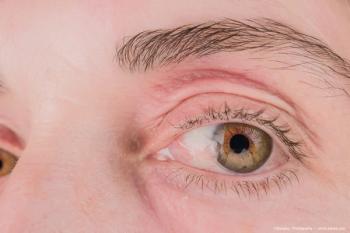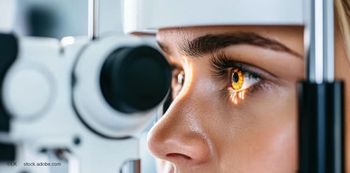
Smartphone screening and referral increases access to care for people with eye problems
According to investigators, the system has been shown to almost triple the number of people with eye problems attending primary care, as well as increasing appropriate uptake of hospital services.
A smartphone-based eye screening and referral system used in one community has been shown to almost triple the number of people with eye problems attending primary care, as well as increasing appropriate uptake of hospital services, compared to the standard approach. The new findings come from research carried out in Kenya.1
Globally, more than 1.1 billion people have a vision problem that is preventable or treatable, often with something as simple as glasses or a cataract operation. Key barriers to care include a lack of access to and awareness of eye services.
Smartphone screenings can help improve access to eyecare, according to a group of investigators.
The controlled, randomly assigned trial included more than 128,000 people in Trans Nzoia County, Kenya, and was carried out by researchers from the International Centre for Eye Health (ICEH) at the London School of Hygiene and Tropical Medicine, Kitale County Hospital, the University of Nairobi and Peek Vision.
Investigators say the results demonstrate the potential of using mHealth tools such as the Peek Community Eye Health system (Peek CEH) evaluated in the trial, to improve access to care, target limited eye health resources, and manage more patients effectively at the primary level so that hospitals can focus on more complex cases.
In low- and middle-income populations, limited access to eye services and a shortage of eye care providers mean there is a high prevalence of avoidable vision impairment.
Peek CEH is a smartphone-based referral system which includes vision screening, SMS reminders to those requiring follow-up appointments, and real-time reporting to follow the patient journey to see who is accessing follow-up care and receiving treatment.
The system evaluated in this trial also incorporated a scientifically validated decision-guiding app1 which enables non-specialist community volunteers to accurately identify and refer patients to eye services.
In the trial, 36 community unit clusters (defined as a health center and its catchment population) were assigned at random to receive either the Peek Community Eye Health System (intervention group) or the standard approach of health-center based outreach clinics (control group).
For the intervention group, community volunteers assessed participants’ vision through door-to-door screening at home using the decision-guiding app.
If the screener identified an eye problem, the participant was automatically referred for triage assessment and received regular personalized SMS reminders about their appointment.
Community sensitization (posters and verbal notices in churches and schools) was carried out in both groups, followed by a triage clinic at the linked health facility four weeks later.
During triage, participants in both groups were assessed and treated, and were referred on to Kitale Eye Unit (hospital) if further treatment was required. Participants in the intervention group received further SMS reminders about their hospital appointment.
The researchers found that the average attendance rate at triage by participants with eye problems was considerably greater in the intervention group where the Peek Community Eye Health system was used compared to the control group (1,429 per 10,000 participants in the intervention group, compared with 522 per 10,000 in the control group - a rate difference of 906 per 10,000 people).
The average hospital attendance rate for those with eye problems was also greater (82 per 10,000 in the intervention group compared with 33 per 10,000 in the control group - a rate difference of 49 per 10,000).
Hillary Rono, PhD, served as lead author of the study. She is an ICEH researcher and ophthalmologist at Kitale Eye Hospital in Kenya.
“My experience as one of very few eye doctors in this rural region of Kenya has shown me that we need more innovative ways to get eye care services to the many people who require them. Our findings show the great potential of using the Peek Community Eye Health system to help ensure that limited health resources are effectively maximized,” she said.
Rono added that previous research has demonstrated that community volunteers using the decision-guiding app were almost as effective at identifying and referring patients with eye problems as an experienced eye health professional.
“These new findings now show that using this app to assess people's vision in their homes as part of the wider Peek CEH leads to many more people accessing the appropriate level of care, which will in many cases transform their lives,” she said.
Moreover, the investigators found that the increase in people with eye problems accessing care did not mean that the hospital became overwhelmed, because most patients (76%) were managed at the primary level.
In fact, when the team compared data obtained in a previous study, they found that the number of patients attending hospital remained at a similar level during the trial, but that the hospital eye services were being used more effectively.
A much lower proportion of people attended hospital for eye problems that could have been treated at the primary level (17.1 % during the trial v 61% previously observed), while the proportion being treated for more serious conditions such as cataract rose from 8% to 62.9%.
Andrew Bastawrous, PHD, a co-author of the study, Peek Vision CEO and ICEH researcher, pointed out that the study demonstrates real systems change.
“This change resulted in the right people getting the right services at the right location, while the specialist services gained much needed capacity to focus on more complex conditions despite a big increase in demand overall being generated,” he explained. “As populations grow and age, the number of people being left behind is increasing. We are delighted to see that this is an evidence-based approach to tackle the growing vision crisis."
The authors note some study limitations, including an SMS message distribution error which was taken into account through further data analysis, and low overall screening coverage, suggesting other approaches to screening should be considered including repeated visits to households to ensure participants are home.
In a separate study earlier this year, a smartphone direct ophthalmoscope attachment (D-EYE) has proved easy to use and successful in visualising the optic disc compared with the direct ophthalmoscope (DO), according to research presented at the virtual annual meeting of the Canadian Ophthalmological Society.
Data from the prospective, randomly assigned, crossover, educational trial involved 44 first-year medical students not familiar with this type of examination, who looked at measurements such as vertical cup-to-disc ratio, fundus matching using an online programme and identifying whether the state of health of the optic nerve was normal or abnormal, according to Rachel Curtis, MD, a fourth-year ophthalmology resident at Queen’s University in Kingston, Ontario, Canada, and the study’s presenting author.
“There is a big push for new technologies and new ways of delivering medical teaching,” Curtis told Ophthalmology Times® during an interview. “The whole concept is finding new technologies to teach medical students [how to examine the optic nerve] and ways to integrate these technologies into practice.”
The smartphone DO attachment lets physicians record the picture or video and show the anatomy, Curtis said.
“It can improve continuity of care by documenting serial exams,” she explained. “It also helps students identify what they are seeing on examination. Your student or ophthalmology resident can show it to your preceptor. Another advantage is that the images or a video can be uploaded into an electronic medical record.”
---
Reference
1. Hillary Rono, PhD, et al; Effectiveness of an mHealth system on access to eye health services in Kenya: a cluster-randomised controlled trial; June 20, 2021, The Lancet; Accessed, June 22, 2021.
Newsletter
Don’t miss out—get Ophthalmology Times updates on the latest clinical advancements and expert interviews, straight to your inbox.













































.png)


